Drivers of Change
“Direct drivers” are factors—of natural or human origin—that cause changes in an ecosystem and thereby increase or decrease its ability to provide certain ecosystem services. Two leading direct drivers expected to affect southern forest extent and distribution over the coming 2–3 decades are suburban encroachment into forests and the reversion of agricultural land back into forest.1 In other words, these two trends of the 20th century are likely to continue. Direct drivers expected to affect forest quality include pest and pathogen outbreaks, fire, and climate change, among others.
These direct drivers, in turn, are being influenced by a range of indirect drivers. For example, suburban encroachment is in part a function of population growth, land use policies, and land values. Combined, these and other drivers will create causal chains impacting southern forest quantity and quality over the next few decades (Figure 4.1).
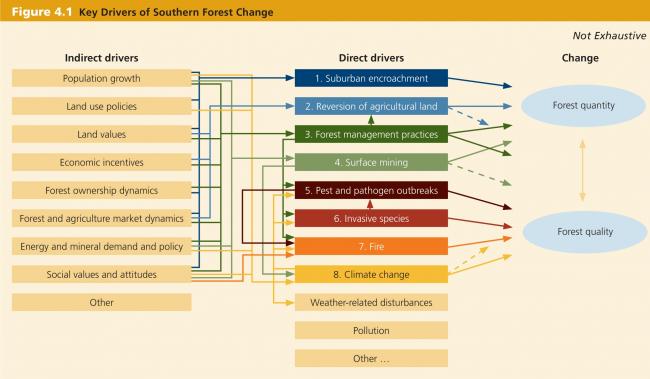 Source: WRI analysis
Source: WRI analysisThe suite of direct drivers includes a mix of factors. Some increase forest quantity (or quality), while others decrease forest quantity (or quality). Similarly, a single direct driver of change can have mixed implications for southern forests. For instance, low-intensity fires can contribute to maintaining forest health, while high-intensity fires can disrupt forest ecosystems and their processes. “Drivers of change,” therefore, should not be interpreted as necessarily having a negative connotation; rather, the phrase merely refers to a factor that causes alterations in forest quantity or quality. Furthermore, some direct drivers such as climate change affect other drivers, and thereby can have a magnified impact on forests.
Suburban encroachment
Conversion of southern forests to suburban development is projected to continue well into the first half of the 21st century. The U.S. Forest Service estimates that suburban encroachment will convert approximately 12 million acres of southern forests to development between 1992 and 2020, and an additional 19 million acres between 2020 and 2040.2 Combined, these 31 million acres comprise an area roughly equal to the size of North Carolina.
Hotspots of projected suburban encroachment on southern forests include (Figure 4.2):
- The outskirts of cities along the Appalachian piedmont or foothills, including Charlotte and Raleigh, North Carolina; Greenville, South Carolina; and Atlanta, Georgia.
- The outskirts of cities on the Atlantic and Gulf coasts.
- The outskirts of cities in the region’s interior, such as Nashville, Tennessee and Birmingham, Alabama.
- The corridor between Washington, D.C. and Richmond, Virginia.
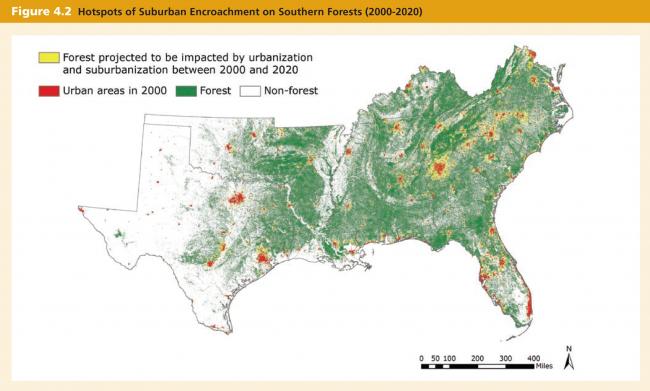 Source: WRI analysis based on housing density projections (Theobald 2008), forest cover (U.S. Geological Survey 2007), administrative boundaries (ESRI Data and Maps 9.3.1, ESRI 2008).
Source: WRI analysis based on housing density projections (Theobald 2008), forest cover (U.S. Geological Survey 2007), administrative boundaries (ESRI Data and Maps 9.3.1, ESRI 2008).Several indirect drivers underlie continued suburban encroachment. One factor is population growth. The region’s population is expected to increase at a rate of 6 to 14 percent per decade through 2030. Most of these new residents will live in urban and suburban areas.
A second factor is land use policies that facilitate low-density development.3 A third factor is land values. As the value of land rises over time, particularly on the outskirts of metropolitan areas, a private forest owner’s financial return per acre of selling forestland to a commercial or residential real estate developer becomes much more attractive than managing forestland for timber, recreation, and/or conservation.
Nonetheless, people need homes. How to accommodate population growth while minimizing further southern forest loss or fragmentation will be a key challenge going forward.
Reversion of agricultural land
Reversion of agricultural land to forest—a trend that grew in the early 20th century—may continue in some rural parts of the South over the coming decades. This forest growth is expected to occur due to active tree planting in response to market prices for timber and biomass for energy, as well as reforestation incentive programs. Some will occur naturally on marginal farmland.4 Forest and agricultural market dynamics, particularly the economic returns of forestry relative to agriculture, will play a major role in determining the scale and pace of this reversion. All else being equal, market forces tend to encourage tree planting when timber or forest-based biomass energy prices rise relative to agricultural prices.
This potential forest gain, however, is not a panacea for southern forests, nor will it likely occur in all parts of the region. The U.S. Forest Service projects that the region will still experience a net loss of 2 million acres of forest from 1992–2020, and another 4 million acres between 2020 and 2040. In addition, some of the gross forest gain will likely be dominated by selected commercially valuable species, while much of the gross forest loss due to suburban encroachment will constitute natural forests with a wider range of species.
Absent this relative price increase, however, even this projected reversion is unlikely to arise. The U.S. Forest Service estimates that stable timber and agricultural prices would lead to no transitions between agriculture and forests.5 In this scenario, losses in southern forest cover would approach a net 31 million acres between 1992 and 2040.6
Energy demand and policies, particularly those regarding renewable energy, will be another indirect driver influencing the amount of agricultural land that may revert to forest. To the degree that non-forest, crop-based energy sources such as corn and soybeans meet this potential demand, the amount of agricultural land that reverts to forest may be lower than expected; forest conversion to agricultural land might occur in some places if demand for crop-based bioenergy is sufficiently high.
Other implications of a possible bioenergy boom for southern forests are still unclear, and stakeholders have expressed multiple perspectives. For instance, bioenergy could generate new income streams for forest landowners, encourage owners to keep their land in forest cover, and stimulate more forest thinning and removal of fuel buildup—a boon to preventing wildfires.7 At the same time, an increase in demand for forest biomass-derived energy could affect the price or availability of wood resources for traditional wood products such as pulp and paper.8 Research on these effects and their possible silvicultural implications is underway.
Forest management practices
How southern landowners manage their forests will shape forest quantity and quality over coming decades. The degree to which forest owners manage their land to yield forest-based ecosystem services will maintain, if not increase, southern forest extent and distribution. The degree to which they actively implement sustainable forest management practices will maintain, if not improve, forest composition and health. Examples of such practices include removing invasive species, conducting prescribed burns in fire-adapted forest ecosystems, maintaining riparian buffer zones, restocking with native species, and implementing other practices.
One challenge going forward is to ensure that forest owners, particularly family forest owners, have sufficient awareness of sustainable forest management practices and the resources to implement them. Studies indicate that only a small share of family forest owners have forest management plans or receive advice about managing their forests.9
One management approach that garners much attention and that will continue to influence the character of southern forests is the establishment of forests planted mainly for the production of timber and pulpwood. Different types of planted forests exist (Figure 4.4).
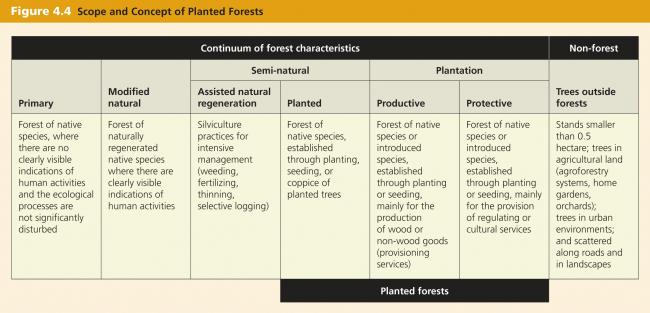 Source: Carle and Holmgren 2008
Source: Carle and Holmgren 2008The predominant species used in plantations or “productive planted forests” in the South are loblolly pine and slash pine, native species valued for their fast growth and versatility for construction timber and paper products. Due to incentive programs, longleaf pine is also gaining popularity.
In 1996, planted forests comprised 36 million acres, or 17 percent of all forestland in the South.10 In 2006, planted forests comprised approximately 43 million acres, or 20 percent of all forestland in the South.11 By 2040, the overall area of productive planted pine forests in the South is expected to increase to 54 million acres12, with Georgia, Florida, and Alabama having the most acreage (Figure 4.5). The degree to which this expected growth is achieved will be a function of global forest product market dynamics13, as well as the availability and relative value of land, among other factors.
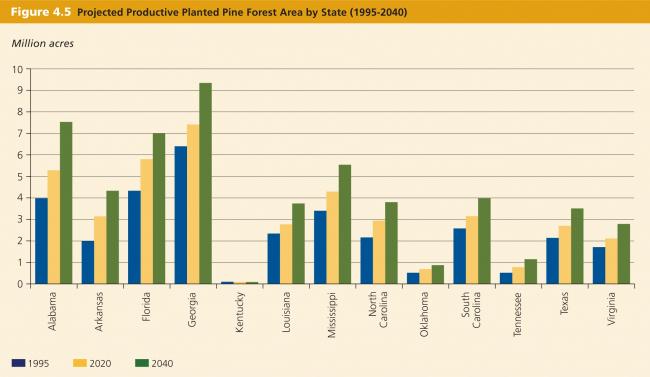 Source: Prestemon and Abt 2002
Source: Prestemon and Abt 2002This expected expansion of productive planted pine forests may impact southern forest extent and composition. To the degree that new planted forests are established on marginal or retired farmland, forest extent will increase. To the degree that they are established in natural forests, forest extent will remain constant, yet forest composition—especially the species mix—will change in those locations. During the 1980s and 1990s, approximately 30 percent of productive planted pine forests in the South were established on agricultural land, while 70 percent were established on converted natural forests. The projected mix over the coming decades is unclear.
Within the broad landscape of southern forests, productive planted forests have the potential to sustain the ability of natural forests to provide non-timber ecosystem services. The intensive management typically associated with productive planted forests—periodic thinning, short rotations, and other practices—nearly doubles yields compared to traditional forest management approaches.14 As such, productive planted forests have the potential to meet demand for timber products more efficiently, thereby facilitating the retention of natural forests for other purposes such as recreation and biodiversity conservation.15
Surface mining
On a more localized basis, various forms of surface mining for minerals and coal can reduce forest extent, at least for a period of time. In addition, they can impact forest quality to the degree that mining degrades soils and subsequent revegetation changes plant and animal species composition.
One surface mining method affecting some portions of southern forests is mountaintop removal. Under this practice, explosives are used to remove large amounts of mountain bedrock, called “overburden,” to expose underlying seams of coal. Forests on the slopes are lost in the process. Additional forest acreage and freshwater streams are buried when the rock, soil, and other debris are deposited into adjacent valleys.16
In the South, mountaintop removal coal mining is concentrated in western Virginia, eastern Kentucky, and some parts of eastern Tennessee (Figure 4.6). The practice occurs in West Virginia, as well, although the state lies outside the South. The practice is estimated to have impacted approximately 1.17 million acres of land, most of it forest, in these four states by the early 2000s.17 The U.S. Environmental Protection Agency estimates that by 2010, 1.4 million acres of Appalachian forests will have been disturbed or cleared by mountaintop removal.18 By law, disturbed areas are to be restored to vegetation by mining operations.
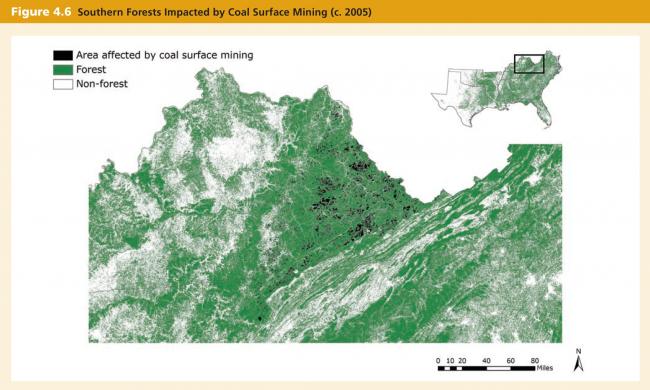 Source: Appalachian coal surface mines (Appalachian voices 2008), forest cover (U.S. Geological Survey 2007), administrative boundaries (ESRI Data and Maps 9.3.1, ESRI 2008).
Source: Appalachian coal surface mines (Appalachian voices 2008), forest cover (U.S. Geological Survey 2007), administrative boundaries (ESRI Data and Maps 9.3.1, ESRI 2008).Pest and pathogen outbreaks
Pests (insects and other invertebrates that are detrimental to human concerns) and pathogens (organisms such as fungi and bacteria that cause disease) can affect the health of forest ecosystems in positive and negative ways. In some circumstances, a pest or pathogen can speed up decomposition and ecological succession in a forest.19 In other circumstances, a pest or pathogen can kill trees of susceptible species, stunt tree growth, change forest species mix, reduce biological diversity, and/or increase the risk of wildfires, among other effects.20 In some cases, a pest or pathogen can effectively eliminate a dominant tree species from the ecosystem, as the chestnut blight did to the American chestnut during the 20th century.
Some pests and pathogens are native to the region. The southern pine beetle, for example, is expected to continue affecting pines in many parts of the South. Its impact has already been felt. Beetle infestations have occurred throughout the region over decades (Figure 4.7), with widespread outbreaks in some years and smaller ones in others. The U.S. Forest Service estimates that approximately 57 million acres are at risk of infestation.
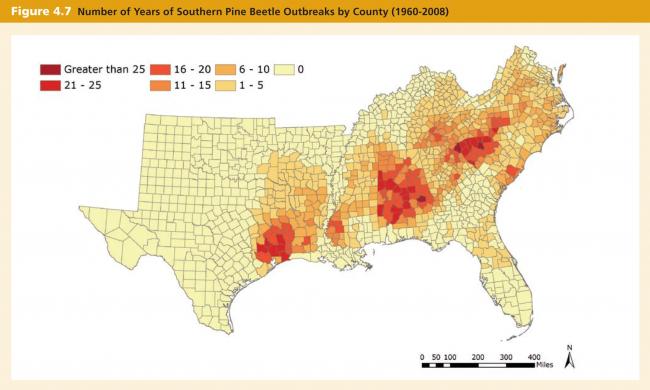 Source: Southern pine beetle outbreaks by county (USDA Forest Service 2009), administrative boundaries (ESRI Data and Maps 9.3.1, ESRI 2008).
Source: Southern pine beetle outbreaks by county (USDA Forest Service 2009), administrative boundaries (ESRI Data and Maps 9.3.1, ESRI 2008).Other pests and pathogens are non-native, having been introduced from other regions or continents into the South, primarily through human activity. The gypsy moth, for example, is a Eurasian species whose caterpillar defoliates basswood, oak, sweetgum, and other hardwoods. Currently affecting forests in Virginia and northward, the pest is expected to continue spreading further into the South. The sirex wood wasp is a recent arrival from Eurasia and is emerging as a new pest threat to pines, having caused 80 percent mortality in productive planted loblolly pine forests in other countries.21 The hemlock woolly adelgid is projected to cause mortality of most eastern hemlocks in southern forests.22 First observed in Georgia in 2002, laurel wilt of redbay—a fungal disease spread by the ambrosia beetle—threatens to decimate native red bay trees.23 In general, non-native pests and pathogens have greater potential than do native ones to restructure forest ecosystems or otherwise impact forest health because non-native species often lack natural predators or pathogens.24
The dynamics of pest and pathogen outbreaks is influenced by the availability and condition of host plants or pathogen targets. For example, the growing prevalence of productive planted pine forests in the South has contributed to outbreaks of southern pine beetle and fusiform rust, since both target pine species. Such risks can be mitigated to some degree, however, by appropriate forest management practices such as wider tree spacing and better matching of species to sites.
Invasive species
Invasive species are expected to continue to impact southern forest quality over the coming decades.25 An invasive species is a non-native organism whose introduction to an area causes, or is likely to cause, damage to ecosystems or ecological processes. For instance, invasives can cause populations of native species that have little resistance to a non-native pathogen or predator to dwindle. They also can out-compete native species for food, habitat, water, or light. Invasive species may include non-native plants, insects, mammals, birds, reptiles, amphibians, fish, mollusks, crustaceans, or fungi. For centuries, invasives have become established by humans through deliberate introduction, unintentional release, and accidental importation.
Southern forests contain numerous invasive species, including but not limited to: * Mimosa trees and Japanese honeysuckle, which were introduced into urban landscapes for aesthetic reasons and subsequently spread into the wild.
- The accidentally imported balsam woolly adelgid, an insect that currently threatens the future of the South’s remnant Fraser fir forests.26
- Kudzu, introduced as a means of controlling erosion and as a potential food for livestock, which has spread to occupy more than 7 million acres in the South.27 “The vine that ate the South” forms dense mats of vegetation over the shrub layer and edges of many forests.
- Cogon grass, introduced to reduce soil erosion, which has spread across millions of acres of southern forest landscapes. Considered one of the “top 10 worst weeds in the world,” cogon grass affects pine productivity and survival, wildlife habitat, recreation, native plants, and fire behavior. Flammable oils in cogon grass blades raise the temperature and severity of fires, increasing the risk of converting low-intensity, fuel-reducing fires into high-intensity, crown fires.28
- Japanese stiltgrass, first observed in Tennessee in 1919. Well-adapted to low-light conditions, this Asian grass has spread to states including Georgia, North Carolina, and Virginia. It spreads to form extensive patches that displace native species incapable of competing with it.29
Fire
Some forest ecosystems in the South adapted over millennia to coexist with fire of both natural and human origin. Often caused by lightning strikes during the region’s frequent thunderstorms, fire is a natural part of these ecosystems and can be an important, beneficial direct driver of forest health. For instance, frequent low-intensity fires are critical for maintaining the flowering plant diversity of longleaf pine forests30 and for ensuring successful oak regeneration.
Starting around the 1930s, however, fire suppression emerged as an objective of public forestry programs across the United States. Fire was considered a waste of timber resources and a threat to human life and property.31 Forest fires in the South and elsewhere thereafter declined.32
Fire suppression has had at least two major effects on forest health. First, it has altered forest density and species composition. For example, when natural fires are suppressed, stands of longleaf pine grow thicker, hardwoods encroach, and the understory plant diversity—and dependent faunal diversity—diminishes.33 One consequence is that longleaf pine seedling recruitment declines, making it more difficult for the longleaf ecosystem to regenerate itself. Second, fire suppression has increased the probability of high-intensity wildfires that burn large areas of forest, burning even the crowns of mature trees of fire-adapted species. This occurs because understory vegetation such as shrubs and woody debris accumulate, creating fuel loads for wildfires.
Although forest management policy is shifting toward the use of managed or controlled fire as an approach to reduce excess fuel loads and restore natural forest ecosystems, fire management may be an ongoing challenge in the South. Willingness to use prescribed burns as a forest management tool is constrained by several factors. Air quality and smoke regulations, particularly in forests near population centers and residential development, can result in burning restrictions. Moreover, some landowners are concerned about legal liability and local public opinion if one of their prescribed burns were to encroach upon a neighbor’s property.
At the same time, several factors may contribute to the continued buildup of fuel. For instance, pests and pathogens that kill trees in the region leave flammable debris in the landscape. Changes in climate and the drought cycle may increase the probability of longer and more intense fire seasons in several regions of the United States, with the South predicted to be an area of special vulnerability. In fact, the South is already a major center of wildfire in the United States. Between 2003 and 2007, approximately 1.17 million acres burned each year in the region. This is the highest average number of forest acres burned due to wildfires of any region in the United States besides Alaska.34
Climate change
Climate has played a major role in shaping the extent, distribution, and composition of southern forests for millennia (see Chapter III), and many forest species have adapted to specific climatic conditions. Therefore, as Earth’s climate changes during the 21st century35, southern forests will change as well. Although implications for specific locations over time are difficult to predict, climate change may have a variety of impacts on southern forests, including:
- The natural range of certain plant and animal species may shift. Species conditioned to cooler climates such as spruces may retreat northward and/or to higher altitudes. Species conditioned to warmer climates such as sweetgum and longleaf pine may expand their range northward along portions of their ranges.36 The area of suitable conditions for other species, such as yellow poplar, may decline (Figure 4.8). As species ranges shift, the ability of parks and protected areas to serve as refuges for some types of plant and animal species may decline. For example, Great Smoky Mountains National Park may lose more than 16 percent of its current mammalian diversity as the park’s ecosystems adjust to climate change.37
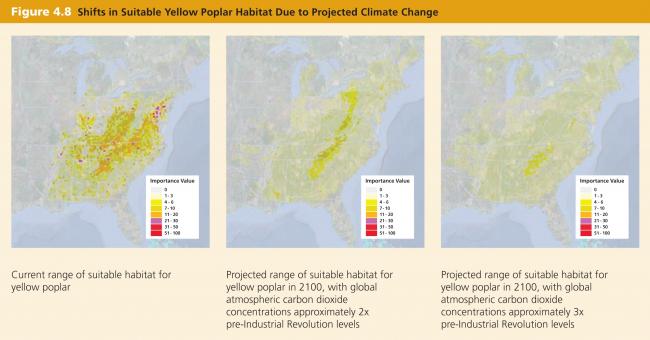 Source: Prasad et al. 2007-ongoing
Source: Prasad et al. 2007-ongoing- Some coastal forests, such as low-lying cypress swamps, may decline in extent and health due to an increase in inundation and saltwater intrusion as sea levels rise.38
- Changing precipitation patterns may increase the frequency and intensity of wildfires.39
- Forest species composition may change if drought-sensitive species decline in number or become more susceptible to pests and pathogens.40
- Large tracts of coastal forest may be impacted by extreme weather events, including hurricanes. For instance, Hurricane Katrina felled an estimated 320 million trees along the coast of Louisiana and Mississippi in 2005. Rising sea temperatures associated with climate change are projected to increase the intensity of tropical storms and hurricanes.41
- As atmospheric carbon dioxide concentrations increase and growing seasons lengthen, some species of trees may increase their rate of growth, with hardwood productivity likely to increase more than softwood productivity.42 This “fertilization effect” may be limited, however, if trees face constraining growth factors such as too little available nitrogen.43
-
Wear, David N., and John G. Greis, eds. 2002a. Southern Forest Resource Assessment. Gen. Tech. Rep. SRS-53. Asheville, NC: U.S. Department of Agriculture, Forest Service, Southern Research Station. ↩
-
Wear, David N. 2002. “Land Use.” In Wear, David N., and John G. Greis, eds. 2002. Southern Forest Resource Assessment. Gen. Tech. Rep. SRS-53. Asheville, NC: U.S. Department of Agriculture, Forest Service, Southern Research Station. ↩
-
Macie, Edward A., and L. Annie Hermansen, eds. 2002. Human Influences on Forest Ecosystems: The Southern Wildland-Urban Interface Assessment. General Technical Report SRS-55. Asheville, NC: U.S. Department of Agriculture Forest Service, Southern Research Station. ↩
-
Wear, David N. 2002. “Land Use.” In Wear, David N., and John G. Greis, eds. 2002. Southern Forest Resource Assessment. Gen. Tech. Rep. SRS-53. Asheville, NC: U.S. Department of Agriculture, Forest Service, Southern Research Station. ↩
-
Wear, David N. 2002. “Land Use.” In Wear, David N., and John G. Greis, eds. 2002. Southern Forest Resource Assessment. Gen. Tech. Rep. SRS-53. Asheville, NC: U.S. Department of Agriculture, Forest Service, Southern Research Station. ↩
-
Wear, David N., Douglas R. Carter, and Jeffrey Prestemon. 2007. The U.S. South’s Timber Sector in 2005: A Prospective Analysis of Recent Change. Gen. Tech. Rep. SRS-99. Asheville, NC: U.S. Department of Agriculture, Forest Service, Southern Research Station. ↩
-
Dwivedi, Puneet, and Janaki R.R. Alavalapati. 2009. “Stakeholders’ perceptions on forest biomass-based bioenergy development in the southern U.S.” Energy Policy 37: 1999–2007. ↩
-
Abt, Robert C. and Karen L. Abt. 2010. “Potential Impact of Bioenergy Demand on the Sustainability of the Southern Forest Resource.” Journal of Sustainable Forestry (forthcoming). ↩
-
Butler, B.J. 2008. Family forest owners of the United States, 2006. Gen. Tech. Rep. NRS-27. Newtown Square, PA: U.S. Department of Agriculture, Forest Service, Northern Research Station. ↩
-
Smith, W. Brad, Vissage, John S., Darr, David R., and Sheffield, Raymond M. 1997. Forest Resources of the United States, 1997. GTR-NC-219. St. Paul, MN: U.S. Department of Agriculture, Forest Service. North Central Research Station. ↩
-
Smith, W. Brad, Miles, Patrick D., Perry, Charles H., and Pugh, Scott A. et al. 2009. Forest Resources of the United States, 2007. Gen. Tech. Rep. WO-78. Washington, DC: U.S. Department of Agriculture, Forest Service. ↩
-
Wear, D.N. and J.G. Greis. 2002b. The Southern Forest Resource Assessment: Summary Report. Gen. Tech. Rep. SRS-54. Asheville, NC: U.S. Department of Agriculture, Forest Service, Southern Research Station. ↩
-
Prestemon, Jeffrey P., and Robert C. Abt. 2002. “Timber Products Supply and Demand.” In Wear, David N., and John G. Greis, eds. Southern Forest Resource Assessment. Gen. Tech. Rep. SRS-53. Asheville, NC: U.S. Department of Agriculture, Forest Service, Southern Research Station. ↩
-
Prestemon, Jeffrey P., and Robert C. Abt. 2002. “Timber Products Supply and Demand.” In Wear, David N., and John G. Greis, eds. Southern Forest Resource Assessment. Gen. Tech. Rep. SRS-53. Asheville, NC: U.S. Department of Agriculture, Forest Service, Southern Research Station. ↩
-
Baker, James C. and William C. Hunter. 2002. “Effects of Forest Management on Terrestrial Ecosystems.” In Wear, David N., and John G. Greis, eds. Southern Forest Resource Assessment. Gen. Tech. Rep. SRS-53. Asheville, NC: U.S. Department of Agriculture, Forest Service, Southern Research Station. ↩
-
USEPA (U.S. Environmental Protection Agency). 2009. “Mid-Atlantic Mountaintop Mining.” ↩
-
USEPA (U.S. Environmental Protection Agency). 2005. Final Programmatic Environmental Impact Statement (PEIS) on Mountaintop Mining/Valley Fills in Appalachia – 2005. EPA 9-03-R-05002. Washington, DC: U.S. Environmental Protection Agency. ↩
-
USEPA (U.S. Environmental Protection Agency). 2005. Final Programmatic Environmental Impact Statement (PEIS) on Mountaintop Mining/Valley Fills in Appalachia – 2005. EPA 9-03-R-05002. Washington, DC: U.S. Environmental Protection Agency. ↩
-
Ward, J.D., and P.A. Mistretta. 2002. “Impact of Pests on Forest Health.” In Wear and Greis, eds. Southern Forest Resource Assessment. Gen. Tech. Rep. SRS-53. Asheville, NC: U.S. Department of Agriculture, Forest Service, Southern Research Station. ↩
-
Ward, J.D., and P.A. Mistretta. 2002. “Impact of Pests on Forest Health.” In Wear and Greis, eds. Southern Forest Resource Assessment. Gen. Tech. Rep. SRS-53. Asheville, NC: U.S. Department of Agriculture, Forest Service, Southern Research Station. ↩
-
Haugen, Dennis A,. and Richard E. Hoebeke. 2005. “Sirex woodwasp-Sirex noctilio F. (Hymenoptera: Siricidae) Pest Alert.” NA-PR-07-05. Newton Square, PA, USDA Forest Service, Northeastern Area State and Private Forestry. ↩
-
Ward, J.D., and P.A. Mistretta. 2002. “Impact of Pests on Forest Health.” In Wear and Greis, eds. Southern Forest Resource Assessment. Gen. Tech. Rep. SRS-53. Asheville, NC: U.S. Department of Agriculture, Forest Service, Southern Research Station. ↩
-
Culbert, Dan. 2008. “Bye-Bye Red Bays.” Okeechobee, FL: University of Florida, IFAS Extension Service. ↩
-
Ward, J.D., and P.A. Mistretta. 2002. “Impact of Pests on Forest Health.” In Wear and Greis, eds. Southern Forest Resource Assessment. Gen. Tech. Rep. SRS-53. Asheville, NC: U.S. Department of Agriculture, Forest Service, Southern Research Station. ↩
-
Ward, J.D., and P.A. Mistretta. 2002. “Impact of Pests on Forest Health.” In Wear and Greis, eds. Southern Forest Resource Assessment. Gen. Tech. Rep. SRS-53. Asheville, NC: U.S. Department of Agriculture, Forest Service, Southern Research Station. ↩
-
Ward, J.D., and P.A. Mistretta. 2002. “Impact of Pests on Forest Health.” In Wear and Greis, eds. Southern Forest Resource Assessment. Gen. Tech. Rep. SRS-53. Asheville, NC: U.S. Department of Agriculture, Forest Service, Southern Research Station. ↩
-
Wear, D.N. and J.G. Greis. 2002b. The Southern Forest Resource Assessment: Summary Report. Gen. Tech. Rep. SRS-54. Asheville, NC: U.S. Department of Agriculture, Forest Service, Southern Research Station. ↩
-
Florida Department of Agriculture & Consumer Services, Division of Forestry. 2004. “Beware of Cogon Grass.” ↩
-
Plant Conservation Alliance’s Alien Plant Working Group. 2008. “Japanese Siltgrass.” ↩
-
Stanturf, John A., Dale D. Wade, Thomas A. Waldrop, Deborah K. Kennard, and Gary L. Achtemeier. 2002. “Background Paper: Fire in Southern Forest Landscapes.” In Wear and Greis, eds. Southern Forest Resource Assessment. Gen. Tech. Rep. SRS-53. Asheville, NC: U.S. Department of Agriculture, Forest Service, Southern Research Station. ↩
-
Macie, Edward A., and L. Annie Hermansen, eds. 2002. Human Influences on Forest Ecosystems: The Southern Wildland-Urban Interface Assessment. General Technical Report SRS-55. Asheville, NC: U.S. Department of Agriculture Forest Service, Southern Research Station. ↩
-
Houghton, R.A., J.L. Hackler, and K.T. Lawrence. 2009. “Changes in Terrestrial Carbon Storage in the United States. 2: The Role of Fire and Fire Management.” Woods Hole, MA. Global Ecology and Biogeography 9:145–170. ↩
-
Stanturf, John A., Dale D. Wade, Thomas A. Waldrop, Deborah K. Kennard, and Gary L. Achtemeier. 2002. “Background Paper: Fire in Southern Forest Landscapes.” In Wear and Greis, eds. Southern Forest Resource Assessment. Gen. Tech. Rep. SRS-53. Asheville, NC: U.S. Department of Agriculture, Forest Service, Southern Research Station. ↩
-
National Interagency Fire Center. 2008. 2009 Quadrennial Fire Review. ↩
-
Solomon, S. D. et al., eds. 2007. “Summary for Policymakers.” In: IPCC. Climate Change 2007: The Physical Science Basis. Contribution of Working Group I to the Fourth Assessment Report of the Intergovernmental Panel on Climate Change. Cambridge, England, and New York: Cambridge University Press. ↩
-
Hoyle, Zoe. 2008. “That Carbon Dance.” Compass: Perspectives and Tools to Benefit Southern Forest Resources from the Southern Research Station 10: 7-14. ↩
-
Burns, C.E., K.M. Johnston, and O.J. Schmitz. 2003. “Global climate change and mammalian species diversity in U.S. national parks.” Proceedings of the National Academy of Sciences 100(20): 11474–11477. ↩
-
Hoyle, Zoe. 2008. “That Carbon Dance.” Compass: Perspectives and Tools to Benefit Southern Forest Resources from the Southern Research Station 10: 7-14. ↩
-
National Interagency Fire Center. 2008. 2009 Quadrennial Fire Review. ↩
-
Winnet, Steven M. 1998. “Potential effects of climate change on U.S. forests: a review.” Climate Research 11: 39–49. ↩
-
Solomon, S. D. et al., eds. 2007. “Summary for Policymakers.” In: IPCC. Climate Change 2007: The Physical Science Basis. Contribution of Working Group I to the Fourth Assessment Report of the Intergovernmental Panel on Climate Change. Cambridge, England, and New York: Cambridge University Press. ↩
-
Alvarez, M. 2007. The State of America’s Forests. Bethesda, MD: Society of American Foresters. ↩
-
Norby, R. et al. 2005. “Forest response to elevated CO2 is conserved across a broad range of productivity.” Proceedings of the National Academy of Sciences 102:18052–18056. ↩



